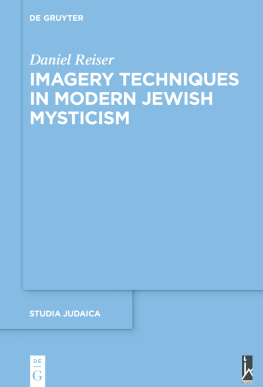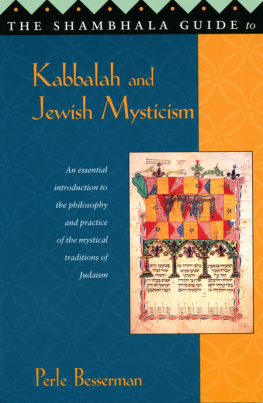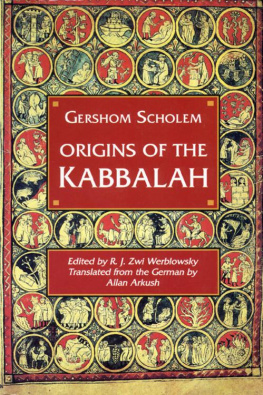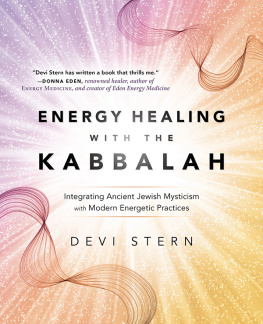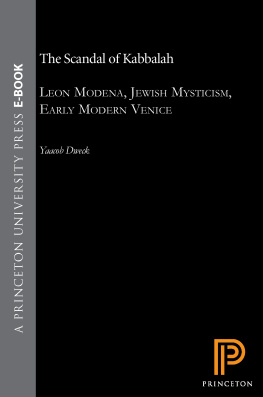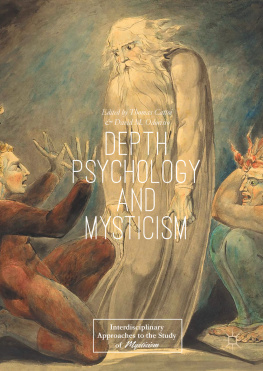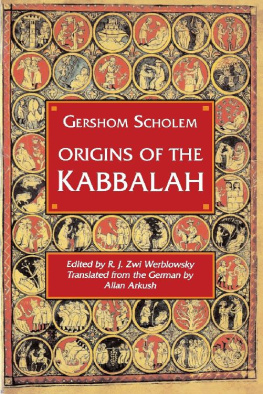Contents
Guide

Daniel Reiser
Imagery Techniques in Modern Jewish Mysticism
Studia Judaica

Forschungen zur Wissenschaft des Judentums
Begrndet von
Ernst Ludwig Ehrlich
Herausgegeben von
Gnter Stemberger, Charlotte Fonrobert,
Alexander Samely und Irene Zwiep
Band 101
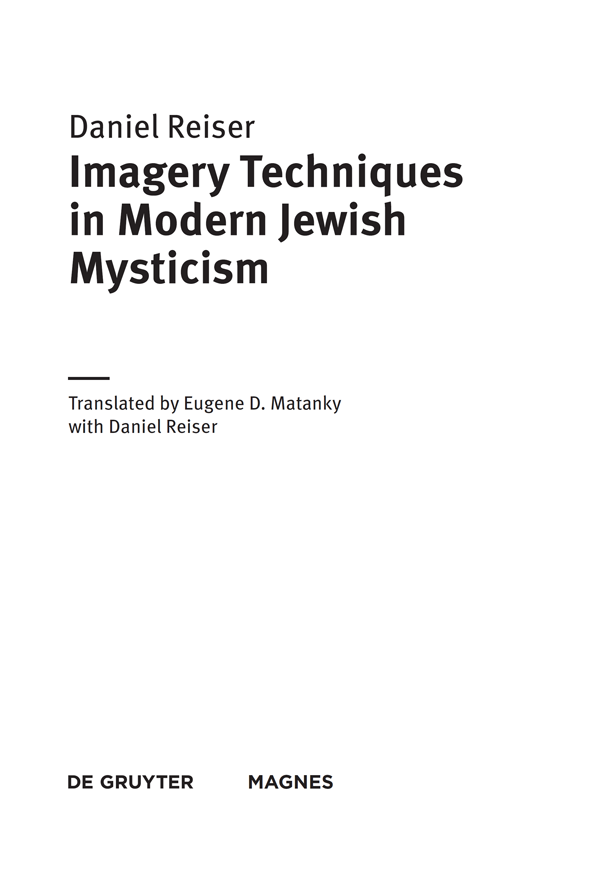
This book was published with the support of the Israel Science Foundation (ISF) and with the support of Zefat Academic College Research Grants.
ISBN 978-3-11-053394-1
e-ISBN (PDF) 978-3-11-053588-4
e-ISBN (EPUB) 978-3-11-053408-5
ISSN 0585-5306
Library of Congress Cataloging-in-Publication Data
Names: Reiser, Daniel, 1976- author.
Title: Imagery techniques in modern Jewish mysticism / Daniel Reiser.
Description: First edition. | Boston ; Berlin : De Gruyter, [2018] | Series: Studia Judaica,
ISSN 0585-5306 ; band 101 | Includes bibliographical references.
Identifiers: LCCN 2018022976| ISBN 9783110533941 (print) | ISBN 9783110535884 (e-book (pdf)
| ISBN 9783110534085 (e-book (epub)
Subjects: LCSH: Imagery (Psychology)--Methodology--History--20th century. | Imagination
(Philosophy)--History--20th century. | Visualization--Technique--History--20th century. |
Mysticism--Judaism--History--20th century.
Classification: LCC BF367 .R45 2018 | DDC 153.3/2--dc23 LC record available athttps://lccn.loc.gov/2018022976
Bibliografic information published by the Deutsche Nationalbibliothek
The Deutsche Nationalbibliothek lists this publication in the Deutsche Nationalbibliografie; detailed bibliografic data are available on the Internet at http://dnb.dnb.de.
2018 Walter de Gruyter GmbH, Berlin/Boston
www.degruyter.com
www.magnespress.co.il
Acknowledgements
Cinema makes movement the immediate given of the image It is only when movement becomes automatic that the artistic essence of the image is realized: producing a shock to thought, communicating vibrations to the cortex, touching the nervous and cerebral system directly Automatic movement gives rise to a spiritual automaton in us.
The status of the imagination has surged in contemporary culture, even being capable of preceding and dictating reality. People of imagination: artists, novelists, actors, and musicians, gain popularity and influence, while people of intellect: intellectuals, philosophers, scientists, and academics lose recognition and effect. Images produce a reality that further reflects these images. This development did not occur in a vacuum, but rather is a cultural aspect that germinated within and already characterized the modern era. A minority of religious authorities and figures were attuned to this development and employed it for their own purposes. I will discuss these select individuals in this work and demonstrate how they utilized the imagination as a means for religious and even mystical experience.
This study began as my doctoral dissertation, entitled, To Fly like Angels: Imagery or Waking Dream Techniques in Hasidic Mysticism in the First Half of the Twentieth Century, (Hebrew University of Jerusalem, 2011). This served as the foundation for my Hebrew book Vision as a Mirror (Los Angeles: Cherub Press, 2014), upon which I have expanded and inserted significant alterations. Vision as a Mirrors scope extends beyond hasidism, with an emphasis on examining and contrasting similar imagery techniques developed in both Jewish and non-Jewish contexts, such as the Lithuanian Musar movement, modern psychological studies, and the East. Vision as a Mirror was awarded the World Union of Jewish Studies Matanel Prize for the best book in Jewish Thought published during the years 20132014.
This current book, Imagery Techniques in Modern Jewish Mysticism , is not just a translation of the Hebrew book, but rather also includes revisions and updated research. In the last four years, new research has been published that has added more sophisticated perspectives on the subject of my study and I have engaged them in this book. Additionally, I have expanded and revised portions of the book in light of the constructive criticism which it received when originally published. My first book was meant for a Hebrew reading audience, whereas this current book is meant for an English reading audience. The change in audience also caused changes to be made in the book. I shortened entire sections that had received much attention in English-based studies prior to my Hebrew book, since it would be superfluous to restate them in this translation. Instead, I have sufficed with referencing the academic research, without expanding upon it. In contrast, the Hebrew concepts and terminology which served me in my research have been clarified in English.
I must express my deepest gratitude to my teachers and friends that have assisted me in every step of this work. First and foremost, Prof. Moshe Idel, under whom I wrote my dissertation. His many insights and conceptions are to be found strewn throughout this book. Without his critical comments and expansive knowledge, this work would have remained like a sheep without a shepherd. Prof. Jonathan Garb, who wrote and published a review of my Hebrew book and made important comments, which influenced certain changes made in this English edition. Prof. Daniel Abrams, the book series editor of Cherub Press, who not only encouraged me to publish my research and carefully edited the Hebrew version of this work, despite his many other pressing obligations, but who has also graciously allowed for its English translation.
I would like to acknowledge the generous support of my current academic homes, Zefat Academic College and its research authority, which supported this translation, and to Herzog Academic Colleges research authority and its director Dr. Amos Geula, who submitted this research successfully for an ISF book grant. I would like to express my sincere gratitude to the Israel Science Foundation (ISF) for their generous financial assistance in the publishing of this English translation.
A few of the chapters included in this work previously appeared in abbreviated form in the journal Modern Judaism. I would like to thank its editor, Prof. Steven Katz, for allowing them to be republished here. Likewise, chapter eight was improved upon in a research program of the Center for Austrian Studies, European Forum, at the Hebrew University of Jerusalem. I would also like to thank the City of Vienna Scholarship for its support.
I cannot express my thanks to Gene Matanky, the translator of the book. He is not just a translator, but a scholar in his own right, I am sure that we will see his own work in the near future. Over the course of this translation, Gene referred me to materials and sources that I had not come across, which have entered this work. The translation of this book became a shared learning experience in which he would ask and I would answer, and I would ask and he would answer. Our enjoyable and productive collaborative efforts have formed the book in front of you. I would also like to thank Sam Glauber who carefully edited the English manuscript and made important stylisic suggestions.
My gratitude to the Hebrew University Magnes Press, Jerusalem, and to the De Gruyter Press for publishing the English translation of my book.
May this book be an illui neshamah , an elevation of the soul, for my grandparents, Sigmund and Carole Reiser, and Aharon and Devora Rosenberg blessed be their memories, Holocaust survivors brands plucked from the fire (Zechariah 3:2); my great-grandparents, Binyamin and Feiga Reiser, Moshe Salamon, Yaakov and Leah Klamer, and Shmuel and Rivka Rosenberg, who were murdered by the Nazis, may their names be erased.

